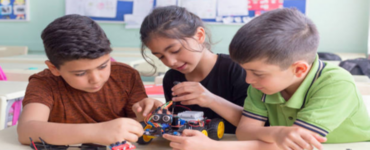Anna Meyer
This study explores the effectiveness of co-teaching in improving the academic performance of multilingual learners in mathematics and beyond. Findings demonstrate better academic outcomes, sustained progress, and higher engagement of students in co-taught classes, while teachers involved in the following co-teaching study highlight the benefits of combining language and content instruction.
Keywords: co-teaching, co-planning, Language Instruction Education Program (LIEP), sheltered instruction, WIDA proficiency levels, Students with Limited or Interrupted Formal Education (SLIFE)
Bridging language and learning
Multilingual learners (MLLs) comprise an increasingly significant portion of the student population and roughly 31.2% of students in a Minnesota high school are receiving MLL services (Minnesota Report Card, 2023). With such high numbers comes great focus and responsibility to determine how best to meet the needs of these diverse groups of learners while also following service minute requirements mandated by the Minnesota Department of Education (MDE) as implemented in the district’s Language Instruction Education Program (LIEP). As sheltered English instruction is often the main course of action, students have limited ability to enroll in credit-bearing classes, resulting in many MLLs facing potential delays in their progress toward graduation. To compensate for this dilemma, many students must enroll in night school or summer school courses to graduate on time or before aging out of the public school system at age 21.
Co-teaching is sometimes suggested to address this issue in hopes of fulfilling students’ MLL service minute requirements and graduation requirements simultaneously. By integrating MLL support into the general education setting, students can receive the necessary language instruction as applied to context in each content area without having to sacrifice core academic credits.
This study examines the effectiveness of co-teaching in improving students’ academic success, particularly in mathematics, and explores its impact on both student success and teacher perceptions. It focuses on three research questions:
- How effective is co-teaching in secondary algebra classrooms for MLLs?
- How do teachers perceive the impact and importance of co-teaching?
- What do teachers consider essential for effective co-teaching implementation?
Prior research: Equity, access, and success for multilingual learners
As the multilingual learner population in U.S. schools continues to grow, so does the need for teachers to be able to address the cultural, linguistic, and academic needs of their students (Norton, 2013). One should consider that students need to develop their academic language and content knowledge simultaneously, requiring their teachers to work to provide opportunities for language application within content area instruction. Traditionally, pull-out and sheltered instruction models have been the primary approaches for supporting multilingual learners. However, these methods often lead students to miss content and academic language instruction, creating a greater achievement gap (Burley, 2015).
Notably, multilingual learners face large challenges in mathematics. Thompson (2017) found that the achievement gap in math for MLLs is nearly three times larger than the Black-White gap, with these students more likely to need to repeat math courses. Here, the disparity is attributed to the overall structure of sheltered instruction, which has occasionally led to less rigorous coursework, causing students to be less motivated and hindering their overall success.
To address all of these challenges, co-teaching becomes a more inclusive instructional model that allows for MLLs to remain in the mainstream classroom. This approach allows for multilingual educators and content teachers to deliver language and content instruction in a way that enhances both pieces. Co-teachers can work on collaboration skills and integrate their own expertise, philosophies, and strategies to better serve diverse groups of learners. The co-teaching model also creates opportunities for teachers to grow as professionals through their shared instructional responsibilities (Abdallah, 2009).
The approach: Evaluating co-teaching effectiveness
This study examined four algebra class groups: two co-taught and two non-co-taught. The co-taught classes had 47 students (91% MLL, average age 16.4, average proficiency 1.991), including eight students with limited or interrupted formal education (SLIFE), with home languages of Spanish, Creole, and Mam (a Mayan language). The non-co-taught classes had 46 students (89% MLL, average age 16.25, average proficiency 2.19), including four SLIFE, with home languages of Spanish and Oromo. The co-taught classes had one math teacher and two MLL teachers, while the non-co-taught classes had two math teachers (one later co-taught). Interviews were conducted with one MLL teacher and one math teacher, and a journal was kept by another MLL teacher.
The research was conducted at a Minnesota public high school, where roughly 31.2% of students are multilingual learners. All four classes took place in the first 9-10 week quarter of the school year in context. Primary data included 15-minute interviews with eight questions on teacher perception and co-teaching effectiveness, recorded, transcribed, and coded for themes. Thirteen journal entries, taken 1-2 times per week, were also analyzed for themes on teacher perceptions, student behavior/reactions, teacher relationships, and teacher responsibilities. Secondary data from an online gradebook database, Infinite Campus, included grades from the first and last tests of the quarter and students’ final grades. Descriptive and inferential statistics were used to determine the statistical significance of the data sets with SPSS software.
Academic outcomes, teacher insights, and implementation challenges
An independent sample t-test assessed co-teaching effectiveness in secondary algebra for MLLs. The first test (out of 50 points) showed no significant difference (co-taught: 37.46, non-co taught: 35.95). However, on the final test, co-taught students scored significantly higher (39.71 vs. 30.30). Final grades (on a 12-point scale) also showed significant difference (p = < 0.01), with co-taught students averaging 5.81 and non-co taught students 3.17. A paired sample t-test compared student progress over the quarter. The co-taught group scored 37.67 on the first test and 39.27 on the latter, showing no significant change. The non-co taught group dropped from 35.98 to 31.06, a statistically significant decline (p = < 0.01).
Coded teacher interviews revealed three key themes: the value of co-teaching, student engagement, and overall effectiveness. Teachers found co-teaching beneficial for combining strengths, offering individualized support, and providing diverse teaching styles. Students appeared more comfortable with two teachers, increasing their willingness to ask questions. Teachers noted a positive impact on MLLs due to more frequent interventions. Journal entries supported these findings, highlighting extra support in vocabulary, interventions for struggling students, and assistance for those who missed class.
Interviews highlighted key factors for successful co-teaching: partnership and compatibility, roles and responsibilities, and implementation challenges. Teachers stressed the need for open communication, aligned teaching philosophies, and shared classroom practices. Both teachers should share leadership and instructional duties. Challenges included limited co-planning time and inconsistent class pairings (i.e., teaching together only once). Journal entries reinforced the importance of collaboration, consistent policies, individualized support, and jointly determining language focuses for assignments and assessments.
Equity through co-teaching: Findings, implications, and the future
The results of the study suggest three main conclusions:
- MLLs in co-taught classes (and in this case, specifically mathematics) show improved grades as well as sustained improvement throughout the course of a term.
- Teachers believe that there is strong value in co-teaching and a positive relationship between the implementation of co-teaching, student engagement, and success for MLLs.
- Successful co-teaching requires effective communication, mutual respect, and fair division of labor.
Not only did the co-taught students outperform the non-co-taught students on their last tests and final grades, co-taught students also showed growth throughout the course of the term (from the first test to the last test). Due to an increase in sustained success and overall success, it can be determined that providing language instruction intermixed with content instruction gives students a better chance of high achievement. Teachers also show strong belief in the value and importance of co-teaching, acknowledging the positive impact on students while also noting the positive impact it can have between teachers if properly implemented.
The successes of students in co-taught classes suggest that the co-teaching model is effective in improving academic performance for multilingual learners in particular. Schools may consider implementing co-teaching in courses where there is a high number of diverse learners. To maximize the effectiveness of co-teaching, schools should look into and invest in professional development intended to equip educators with vital skills for working as a co-teacher (effective communication, mutual respect, workload-sharing strategies). Trainings should emphasize collaboration between content teachers and English language specialists to seamlessly integrate content and language instruction.
Furthermore, resource allocation is also crucial for successful co-teaching; therefore, proper time for planning and collaboration between co-teachers must be a priority. This will allow teachers to align instruction and address student needs. Sufficient prep time will also allow for teachers to strengthen their co-teacher relationships––something that is vital in sustaining co-teaching. Team-building initiatives that promote trust, mutual respect, and shared responsibilities can allow for a well-supported co-teaching partnership to flourish.
In a broader sense, co-teaching will strengthen equity in education. By integrating language supports into a mainstream instruction environment, the unique challenges faced by MLLs can be properly addressed, which will in turn allow students to have equal access to rigorous academic content. Co-teaching also benefits other student groups, including those that need extra academic support––an overall valuable strategy for inclusive education.
The small sample size, as it includes a limited number of classrooms and students, may be a limitation to this study, potentially reducing the generalizability of the findings. Additionally, variations in classroom environments can also contribute to student success, making it difficult to isolate the effects of co-teaching. The short duration of the study may not capture the long-term impact that co-teaching may have on student outcomes and teacher collaboration. Furthermore, this transition period at the beginning of the school year presents a limitation. There could potentially be deeper benefits to co-teaching such as language proficiency, social-emotional development, and classroom engagement; however, only academic success is explored here. Lastly, the lack of control over external factors such as attendance, home environment, and prior academic experiences may lead to differences between class groups and may impact the study’s results.
Opportunities for further research present themselves in different capacities. Exploring the long-term outcomes of co-teaching would allow for a better understanding of how co-teaching can impact student achievement on a greater scale. The exploration of co-teacher dynamics in the classroom would also allow for better understanding of the importance and impacts teacher relationships may have on the co-teaching effectiveness and overall experience for all involved. Further research might also present the need for co-teaching standards to be put into place for educators in order to better determine utilization of the model. Lastly, the inclusion of accountability systems for teachers may also be a necessary next step.
Notes
1. Average English proficiency scores are based on students’ WIDA ACCESS scores.
References
Abdallah, J. (2009). Benefits of co-teaching for ESL classrooms. Academic Leadership: The Online Journal, 7(1), 9. https://doi.org/10.58809/RUAR2479
Burley, K. R. (2015). A study of how the components of effective co-teaching are implemented in middle school content area classrooms in one suburban school district [unpublished master’s thesis]. Hamline University, St. Paul, MN. Retrievable from https://digitalcommons.hamline.edu/hse_all/240
Minnesota Report Card. (2023). https://rc.education.mn.gov/#mySchool/p–3
Norton, J. (2013). Elementary ESL and general education co-teachers’ perceptions of their co- teaching roles: A mixed methods study [unpublished doctoral dissertation]. George Washington University, Washington, D.C. Retrievable from https://scholarspace.library.gwu.edu/etd/mc87pq395
Thompson, K. (2017). What blocks the gate? Exploring current and former English learners’ math course-taking in secondary school. American Education Research Journal, 54(4), 757-789. https://doi.org/10.3102/0002831217706687











